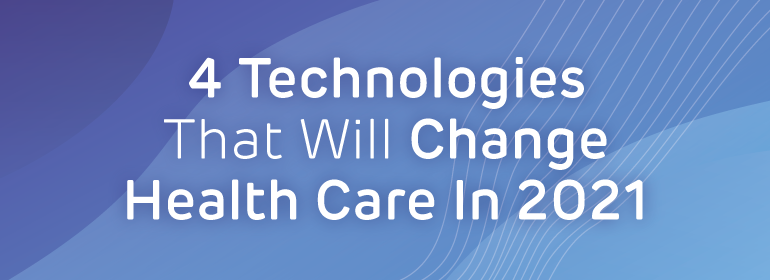The global pandemic has shaken up health care systems around the world, challenging our existing protocols and procedures. Throughout 2020, we’ve seen technological advancements in health care evolve to meet the growing needs of health care professionals and patients alike. With our frontline workers enduring constant exposure to COVID-19 and hospitals and clinics becoming high-risk exposure sites, telemedicine was quickly adopted to safely treat patients – just one example of a health technology that has shifted the view of delivering patient care by transitioning from traditional to a modernized method. Professionals in health IT expect more advancements that will further improve patient care and workloads for health care providers. Here are four trends in health technology we anticipate in 2021.
Download the infographic here.
Cloud-based Information Management Systems
Hospitals and clinics are responsible for storing health records for millions of patients. The EHR was initially introduced in the 1960s to establish a single database that hospitals could access to receive updated patient information before treatment. As of 2017, almost 95% of hospitals nationwide have adopted some type of EHR system. With nearly 4,500 hospitals tapped in, the ability to house all of this data in a better way is the next step towards an improved EHR system.
With a cloud-based EHR, information is instantly uploaded and made available for patients and health care workers. Also, data will be computed faster to provide current health statistics that will benefit researchers and public health officials. Creating a cohesive connected system will reduce idle time spent waiting for the information to successfully transfer from one point to another.
Artificial Intelligence and Machine Learning
AI has been prevalent in health care, but COVID-19 has kickstarted the movement to improve detection and diagnosis. Whatever can be done through contactless means has been transferred to AI in order to protect health care workers and improve overall treatment protocols. This reduces overall workload for doctors and nurses to ensure they have sufficient time to treat and help patients.
AI will influence the general public as well in the form of wearable technology. Health care systems are working to integrate the data collected from smart phones, watches, and bracelets to predict a person’s health trajectory. Such forms of technology will be scalable to help facilities and patient pools of any size.
Telemedicine and Health Apps
We’re already experiencing a movement towards a more autonomous patient and seeing people become more proactive about their health. In 2020, telemedicine played a big role in keeping communication pathways open for non-COVID patients. Patients would be able to video chat with their primary physician and receive a diagnosis and prescription through their health app. To improve on this system and free up doctors’ schedules, health IT professionals are building apps that can diagnose and share treatment pathways giving doctors more time at bedside.
Patients will go through a checklist that asks about their symptoms and that will accurately assign a diagnosis or health concern. The database can be scaled to include diagnoses beyond the most common ailments. Alternatively, health care workers can use the app to deliver accurate diagnoses in seconds. Such resources require great collaborative efforts from health care professionals around the world who can share their expertise about specific illnesses.
Virtual Reality to Propel Education
Shadowing surgeons is a valuable experience for medical students. Given the new regulations that limit the number of people in the OR, such opportunities have been reduced. To combat the knowledge gap, facilities are using VR to create teachable moments with simulated surgeries. This also gives students the opportunity to lead the surgery and apply what they’ve learned.
VR can expand to include a multitude of health situations that will improve patient care. There are programs that mimic how elderly patients move so health care providers are more aware of the body’s limitations as it ages. It can aid in language and cultural exchanges as well to create a more diverse health care experience for patients. Health tech experts recognize the budding opportunities with VR and are developing software that aims to strengthen education.
Eisenhower Health is a leader in innovation to improve patient care for all health conditions. Search for opportunities to work at our world-class medical center on our Career page.
Originally posted on 1/18/2021




